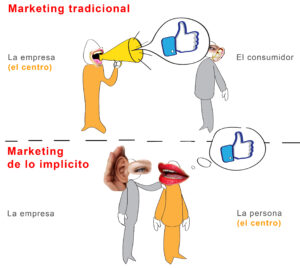Nowadays (May 2013) any scientist would deny the fact that that approximately 85-95% of human decisions are non-conscious or implicit.
When making decisions, we can have a wide variety of doubts: regarding which shop or restaurant to go to, about what product or brand to buy, about which bank to open an account with, about which printer to get, etc.
For decades, we have liked to think of ourselves as “rational animals” and, to an extent this is true, especially when compared with other species. However, the paradox is that only 5-15% of our decisions are conscious.
In the market economy
This conclusion, the result of biological and neuroscientific research, has enormous implications for companies operating in countries with a market economy, in other words across most of the world.
In this kind of market place, every customer has the basic right is to be able to choose where and what to buy. Hence the main purpose of marketing is to try to become, and remain, a customer’s preferred option, so that your company makes a profit.
Being the preferred option is something we have all aspired to ever since we were kids. Do you want to play with me? Do you want to dance? Will you hire me? Will you buy my services?
Up till now, a magic formula
For decades, we have tried to achieve this preference with a kind of magic formula for success, whose recipe varied depending on the magician. In all recipes the ingredients were similar; the only things that changed were the algorithm and the proportions. We have all heard phrases such as “location, location, location” (a simple equation: location raised to the power of three), or else “what is essential is a good quality/price ratio”, etc.
This magic formula has been called ‘the marketing mix’, and it has worked quite well.
However, we now know that it is in the limbic system of the brain where the vast majority of non-conscious and implicit decisions are made – at a rate of 11 Mb per second.
So, it really makes sense to think that the most logical type of marketing should be based on what is implicit.
Implicitness-based marketing
The challenge is to outline the territory of this new marketing approach, since we lack a theoretical system to act as a guide for the practical aspects. Rarely have we been more in need of a suitable theory.
What theories we do have are more like single willow rods than a finished wicker basket. There are a large number of serious publications based on the above mentioned cerebral reality, but I have yet to find a single mention of “implicitness marketing”.
Taking on this challenge, I am gong to attempt to give a few clues about marketing without tags: the most human type of marketing is based on what is implicit.
Therefore, I have ordered my reflections based on the functional blocks of retail marketing:
- The philosophy of the business
- The input capture phase
- The “cooking”
- The output phase: to do and to have
- The way of “doing marketing”
Given that this is quite an experimental subject, I shall present it by comparing traditional marketing with implicitness marketing. I apologise in advance for any us of generalisations or clichés.
| Marketing philosophy | Traditional approach | Implicitness approach |
| Customer | He/she is usually referred to as a “target” to impact. Sometimes he/she is considered as a “robot with a wallet”: if you do an action, they respond in a certain way. |
He/she is considered a person, and moreover, different depending on the context (for example: a person used to sleep less when has a baby). |
| Objective | In order to sell today, you need to convince people. | To be continuously preferred, even when sales promotion ends. |
| Orientation | Market orientation (to be market driven) | To drive the market. Innovate and blaze the trail is a service. It appeals to the limbic system. |
| The job | There are often conflicts between marketing and sales departments. | All the departments should perceive themselves as Customers growers. |
| When looking for inputs | Traditional approach | Implicitness approach |
| Market research objective: | Usually carried out to obtain information about customers. | To understand the customer, visualize, and put a face to them. |
| Subject | In many reports and journals, it is told about “the consumer”. | Attention is paid to each priority segment, in particular to see how they are influenced by their context. |
| Purpose | In many cases, market research is carried out “just in case” the project fails: “to ensure that it doesn’t affects me”. | In order to find a source of inspiration, you need to hunt for genuine “insights” through the fog. If it were that clear, it would be called “outsights”. |
| Method | Knowledgeable specialists in very specific and different subjects are required. | You need to use specialists, but with a polymathic or multidisciplinary approach where humanistic sciences plays a key role. |
| Way | Often with easy to draw answers that can be tabulated and
Often, by the use of questions demanding answers that can be tabulated and to charted later. |
If the aim is to innovate, a qualitative approach must be adopted. In both cases, these approaches include projective techniques. Questions about tell me your reasons are technically in doubt. |
| In the “kitchen” | Traditional approach | Implicitness approach |
| What we aim to cook | New products, new services, new advertising campaigns. | New solutions, if possible quite complete or with parts that can be fitted in, if it is needed. |
| Our resources | Basically, using the company’s own resources. | There might be intelligent life outside the company. Comprehensive solutions can be developed working alongside companies in other sectors. |
| The engine | All the elements of the marketing mix are used. | Above all, the aim is to guess the customers’ replies to the following question on the main retail product (the shop and what happens in it):
Where do you fit into my life? Which sense are you providing me with in this moment of my life? |
| The base | What most advertising agencies ask you: “the reason why”… | Much better to ask “The sense why …”, linked to the previous point.
This is hard to answer with the traditional marketing mix elements. |
| Output phase | Traditional approach | Implicitness approach |
| Communication | The aim is to make the company communicate with them efficiently. | The aim is to have a conversation, to listen, to talk and to empathise. |
| Actions | The focus is on things and actions, “To do + To have”. | First of all, to define “to be” and “to feel”. Later on, “to do” and “to have”. |
| Network use | Both offline and online. | Instead of multichannel or omnichannel, customer-centricity.
Today, when using smartphones we switch between online and offline without noticing. |
| Objectives | To meet the sales targets for a given period. | To increase the Customer Lifetime Value (CLV), since we are all customer growers. |
| Metrics | Ex-post, in other words once things happen (except for budgets). | Both ex-post and ex-ante.
Using artificial intelligence, we can predict the near future. |
| Managerial style | Traditional approach | Implicitness approach |
| Time spent in shops or online | So many minutes: it is increasing. | If the customer spends two hours a month, they are giving us two hours of their life. |
| Customer service | It should be correct. | With the maximum respect: they pay us with money and with their life. |
| Tools usage | Instrumental use. | Targeted towards brain’s automatic pilot: the limbic system.
The cerebral cortex works more slowly and almost always tries to rationalise things that have been decided implicitly. |
| Tone and style | Make everything that is done and communicated clear, in order to be as efficient as possible. | The limbic system likes…
|
Final thoughts
In this bubble I have discussed the changes that have occurred in my field over the last five years, both with regard to academic and consultancy work. In both cases, what I try to do is to think up innovative retail models to improve customers’ quality of life. And the results have been great.
When someone wants to innovate, the main obstacle is not generally the competition, but rather their own non-conscious prejudices, acquired over decades. In the near future, therefore, I hope to be able to improve this draft about implicitness-based marketing in a more comprehensive way.
Bibliography
Nordfalt, J. (2005) Is consumer decision-making out of control? Non-conscious influences on consumer decision-making for fast moving consumer goods. PhD Thesis, EFI, the Economic Research Institute at the Stockholm School of Economics.
Wedel, M.; & Pieters, R. (2007) Visual Marketing: From Attention to Action. New York: Psychology Press, 328 pp.
_____________
Lluis Martinez-Ribes
Source: Código 84, nº 172.





